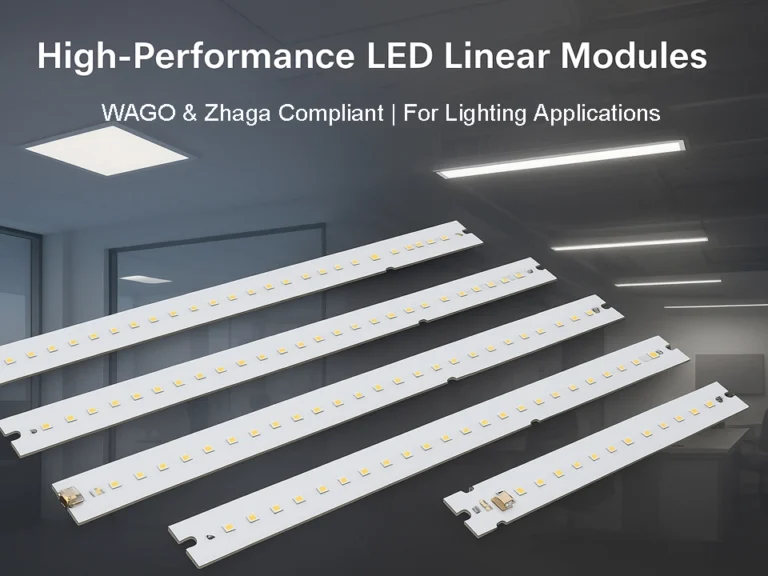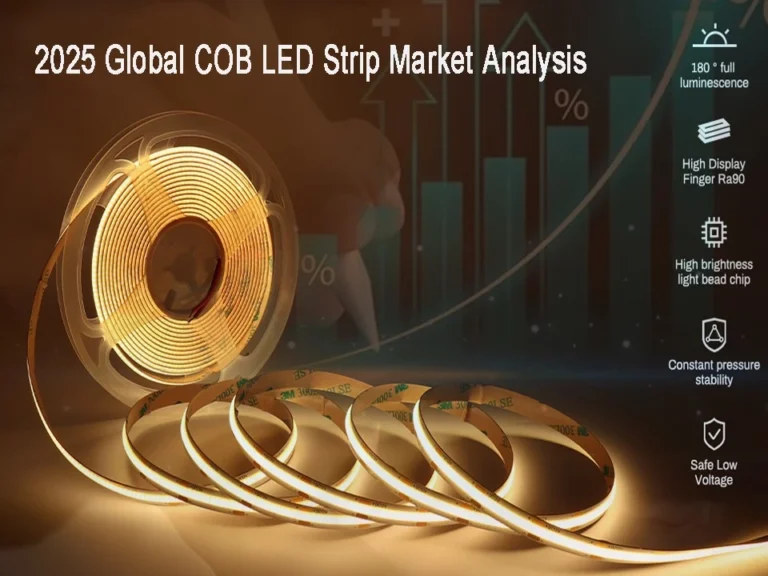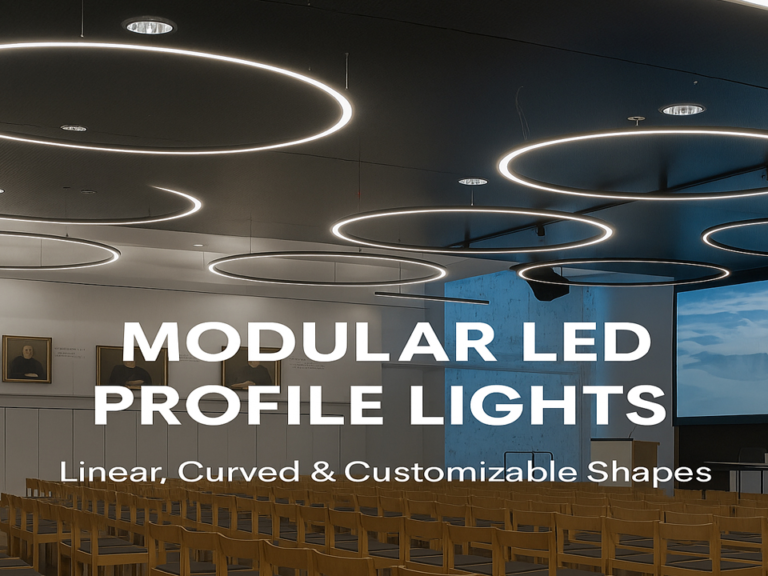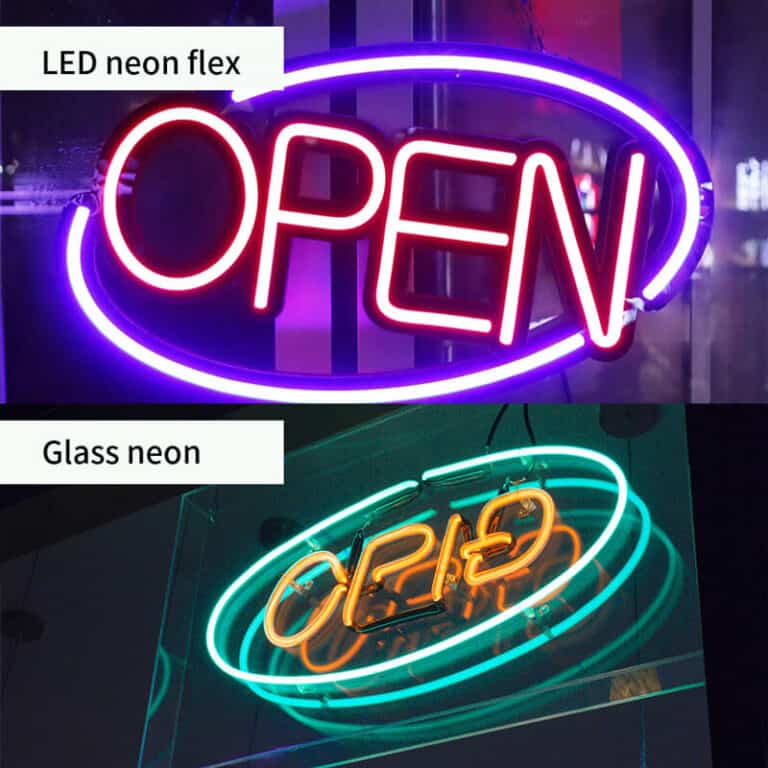LED 조명 기술의 빠른 성장과 Zhaga 컨소시엄의 새로운 표준으로, 선형 LED 모듈 현재 상업용 조명, 건물 장식 및 산업 환경에서 널리 사용되고 있으며, 이는 균일한 빛을 제공하고 다양한 방식으로 설치할 수 있으며 쉽게 교체할 수 있기 때문입니다.
그러나 성능과 수명은 LED 드라이버의 호환성에 크게 의존합니다. 부적합한 드라이버는 불균일한 밝기, 낮은 에너지 효율 또는 모듈 손상을 초래할 수 있습니다.
정전류, 정전압, 선형 옵션과 같은 다양한 드라이버 유형에 직면한 엔지니어 및 조달 전문가는 선형 LED 모듈의 전압, 전류 요구 사항 및 환경 조건을 기반으로 드라이버를 정확하게 선택해야 합니다.
이 문서에서는 핵심 매개변수와 토폴로지 구조를 다루는 체계적인 선택 가이드를 제공하여 LED 선형 모듈과 LED 드라이버 간의 시너지 최적화를 달성하는 데 도움이 됩니다.
LED 드라이버란?
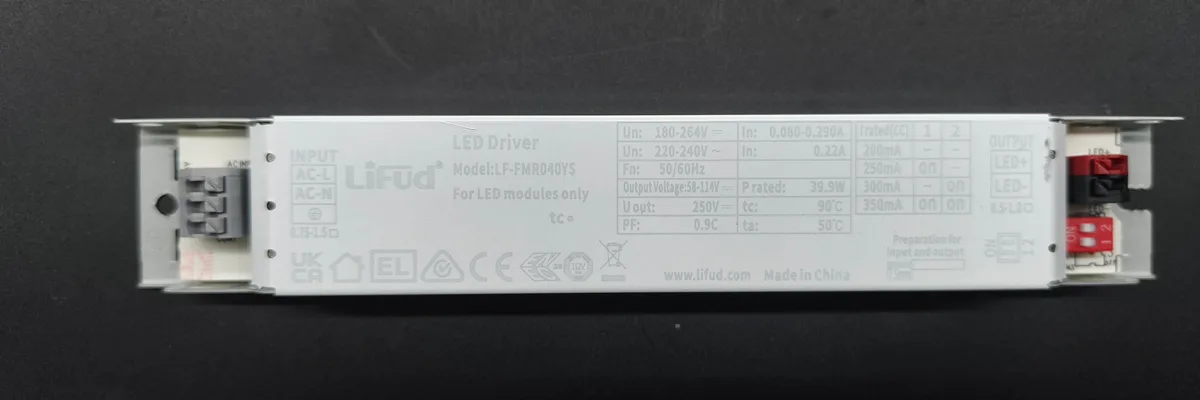
An LED 드라이버 발광 다이오드(LED)에 전력을 공급하도록 특별히 설계된 전자 장치입니다. 주요 기능은 LED가 정상적으로 작동하도록 하기 위해 전류와 전압을 정확하게 제어하는 동시에 LED에 필요한 직류(DC)로 교류(AC)를 변환하는 것입니다.
전원 공급을 넘어서, LED 드라이버는 전류와 전압을 정확하게 조절해야 합니다. LED는 이러한 파라미터의 변동에 매우 민감하며, 작은 편차로도 손상 또는 성능 저하를 유발할 수 있습니다. 따라서 LED 드라이버는 고급 기술 사양과 정교한 제어 기능을 요구합니다.
LED 드라이버를 선택할 때는 특정 LED 조명기구 유형, 전력 요구 사항 및 작동 환경과 같은 요소를 종합적으로 고려해야 합니다.
LED 조명 시스템 내에서 LED 드라이버는 LED에 안정적이고 안정적인 전력을 공급하는 "에너지 허브"일 뿐만 아니라 LED 성능과 수명을 보호하는 중요한 요소 역할을 합니다. 고품질 LED 드라이버는 LED 고정 장치의 발광 효율, 안정성 및 신뢰성을 크게 향상시키면서 고장률과 유지 보수 비용을 줄입니다. 이를 통해 사용자는 보다 에너지 효율적이고 환경 친화적이며 편안하고 편리한 조명 경험을 제공합니다.
정전류(CC) 대 정전압(CV) 드라이버
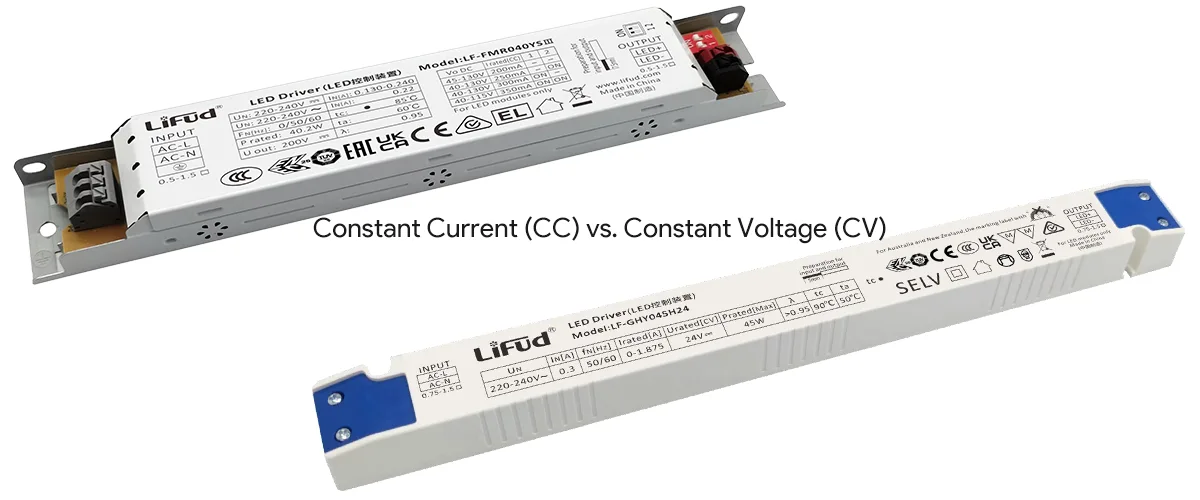
다양한 애플리케이션 시나리오와 요구 사항에 따라 LED 드라이버는 다양한 유형으로 제공됩니다. 출력 모드에 따라 정전류 드라이버와 정전압 드라이버로 분류할 수 있습니다.
- ▼Constant Current 의 장점 ․ 온도에 따른 LED 순방향 전압 변화를 보상하여 수명 연장.
- Ì상수 전압 제한사항: 추가적인 전류 제어 회로 설계가 필요하므로 비용은 낮지만 위험은 더 높습니다.
LED 드라이버를 선택할 때 LED 고정 장치의 유형, 전력 요구 사항 및 작동 환경과 같은 요소를 포괄적으로 고려하는 것이 가장 적합한 드라이버 유형을 선택하도록 하는 데 필수적입니다.
정전류와 정전압 전원 공급 장치의 차이점을 살펴 보겠습니다.
ㆍ지류 LED 박력므
전압이 부하에 따라 변하는 동안 일정한 전류를 출력합니다. 전류 안정성을 유지하기 위해 전류 피드백 루프를 통해 전압을 동적으로 조정합니다. 예를 들어, LED 칩 온도가 상승하고 저항이 감소하면 전원 공급 장치는 전압을 자동으로 낮춰 정전류를 유지합니다.
▼일정전류 드라이버는 단일 또는 다중 LED 스트링을 구동하는 데 적합합니다. 정확한 전류 제어가 가능하여 밝기 드리프트 및 열 폭주를 방지하여 LED 조명에 이상적인 선택입니다. 정전류 전원 공급 장치는 개방 회로 부하(예: 파손된 LED)를 엄격히 금지하지만 단락 회로에서 전압을 조정하여 회로를 보호할 수 있습니다.
ㆍ일정 전압 LED 박력
출력 전압은 일정하게 유지되지만 전류는 부하에 따라 변합니다. 전압 피드백 루프는 출력을 조절합니다. LED를 직접 구동할 때는 직렬 전류 제한 저항이 필요합니다. 그러나 전압 변동으로 인해 전류가 불안정해져 LED 과열 또는 번아웃이 발생할 수 있습니다.
정전압 전원 공급 장치는 주로 LED 스트립과 같은 병렬 연결이 필요한 시나리오에서 사용됩니다. 그들은 저항 페어링을 필요로 하고 고전압 안정성을 요구합니다. 정전압 전원 공급 장치는 LED 조명이 타버릴 수 있으므로 완전한 부하 단락 또는 개방 회로를 경험해서는 안 됩니다.
요약하면, 정전류 전원 공급 장치는 LED 모듈 애플리케이션에서 더 큰 안정성을 제공하는 반면 정전압 전원 공급 장치는 신중한 설계 및 보호 조치가 필요합니다.
추가 자료: "정전압 대 정전류: 상업용 프로젝트에 가장 적합한 LED 스트립은 무엇입니까?"
LED 드라이버 선택 시 핵심 요소
1. 전기 경기
LED 드라이버의 입력 전압을 선택할 때 전압 변동을 고려하면서 로컬 그리드 전압과 일치하는지 확인하십시오. 그리드 전압은 절대적으로 안정적이지 않으며 ±10%만큼 달라질 수 있습니다.
예를 들어, 공칭 220V 공급이 있는 지역에서는 실제 전압이 198V에서 242V까지 다양하므로 선택된 전원 공급 장치의 입력 범위는 이러한 변동을 커버해야 하며, 그렇지 않으면 제대로 작동하지 않거나 손상될 수 있습니다.
입력 전압은 일반적으로 AC(교류 전류)이며 사용되는 전압은 국가에 따라 다릅니다. 예를 들어, 미국과 캐나다는 120V를 사용하고, 일본은 110V를 사용하고, 대부분의 유럽 국가에서는 230-240V를 사용합니다. 다음은 여러 국가에서 사용되는 전압의 참조 표입니다.
대부분 N이양의 V전압 R추론
| 나라 | 전압 | 빈번 |
| 중국 | 220V | 50Hz |
| 일본 | 100V | 50/60Hz |
| 대한민국 | 100V | 60Hz |
| 홍콩 | 200V | 50Hz |
| 태국 | 220V | 50Hz |
| 인도네시아 공화국 | 220V | 50Hz |
| 캐나다 | 120V | 60Hz |
| 아르헨티나 | 220V | 50Hz |
| 멕시코 | 120V | 60Hz |
| U.S.A. | 120V | 60Hz |
| 괌 | 110V | 60Hz |
| 이탈리아 | 220V | 50Hz |
| 독일 | 220V | 50Hz |
| 영국의 | 240V | 50Hz |
| 프랑스 | 127V, 220V | 50Hz |
| 그리스 | 220V | 50Hz |
| 스웨덴 | 120V, 127V, 220V | 50Hz |
| 네덜란드제의 | 220V | 50Hz |
| 노르웨이 | 230V | 50Hz |
| 덴마크 | 220V | 50Hz |
| 스위스 | 220V | 50Hz |
| 핀란드 | 230V | 50Hz |
| 벨기에 | 220V | 50/60Hz |
| 스페인의 | 127V, 220V | 50Hz |
| 오스트리아 | 220V | 50Hz |
LED 드라이버의 출력 전압은 아래와 같이 LED 선형 모듈의 전압과 일치해야 합니다. SignLiteD에서 설계한 560×24 선형 LED 모듈은 DC44V 전압으로 라벨이 붙어 있습니다.이 정격 전압을 기반으로 해당 Leifu FMR040YS 전원 공급 장치를 선택할 수 있으며, 출력 전압 범위는 40V ~ 130V입니다.
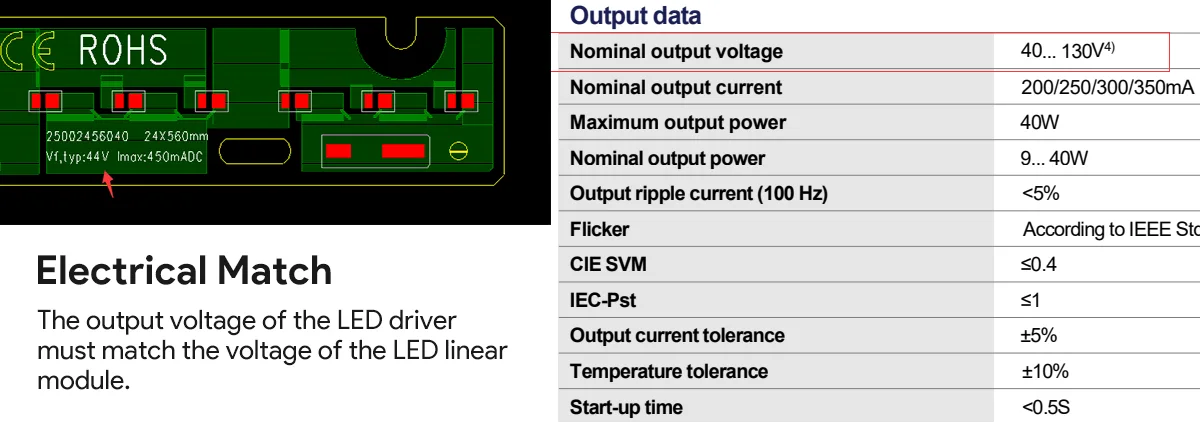
2. 전력 등급 및 효율성
정격 전력은 LED 드라이버가 안정적인 작동 조건에서 제공할 수 있는 최대 전력을 나타냅니다. 운전자의 정격 전력은 LED 조명기구의 전력 요구 사항과 일치해야 합니다. 드라이버를 선택할 때, 조명기의 파워보다 약간 높은 파워 등급을 가진 드라이버를 선택하여 마진을 보장하고 안정성을 향상시킵니다. 예를 들어, 35W LED 선형 모듈은 35-40W LED 드라이버와 페어링되어야 과부하 또는 과부하로 인한 효율성 저하를 방지해야 합니다.
LED 드라이버의 효율성은 입력 전력에 대한 출력 전력의 비율(η) = (출력 전력/입력 전력) × 100%입니다. 예를 들어 100W의 전력이 입력되고 90W의 전력이 출력되면 효율성은 90%입니다. 고품질 드라이버는 90%를 초과하는 효율성을 달성합니다. Tridonic, OSRAM, LINEW 는 일반적으로 90%.
또한 동일한 부하 조건에서 더 높은 전류에서 작동하는 LED 드라이버는 일반적으로 더 낮은 전류에서보다 약간 더 높은 효율을 나타냅니다. 예를 들어, 350mA 드라이버는 100mA 드라이버보다 1-2% 더 효율적일 수 있습니다.
고효율 드라이버를 선택할 때 대기 전력 소비도 고려해야 합니다. 대기전력은 부하가 끊어졌을 때 기본 기능을 유지하기 위해 LED 드라이버가 지속적으로 소비하는 전기 에너지를 말합니다. 부하가 없어도 내부 회로는 무부하 손실(예: 변압기 가열)을 발생시킵니다. EU ERP 지침은 LED 드라이버에 대해 0.5W 이하의 대기 전력 소비를 요구하며 프리미엄 드라이버는 0.3W의 낮은 수준을 달성합니다.
응용 프로그램 권장 사항:
정격 전력을 가진 LED 드라이버를 LED 선형 모듈과 같거나 그 이상으로 선택하면 보다 안정적이고 안정적인 작동이 보장됩니다.
또한 고효율 드라이버를 사용하면 사용자가 전기 비용을 절감하고 장비 발열 및 환경 영향을 줄이며 운전자 자신의 전력 소비와 열 출력을 어느 정도 낮출 수 있습니다. 산업용 애플리케이션의 경우 PF 0.9 이상 및 효율성 ≥ 90%인 드라이버를 우선시합니다. 주거용 애플리케이션의 경우 경부하 효율(예: 20% 부하 시 효율성 > 85%) 및 낮은 대기 전력 소비(≤ 0.5W)에 중점을 둡니다.
3. 디밍 호환성
선형 LED 모듈은 일반적으로 밝기 조정이 조광 가능한 LED 드라이버의 정밀한 제어에 의존하는 정전류 드라이버를 사용합니다. 현재 선형 디밍 드라이버는 주로 다음과 같은 유형을 포함합니다.
- DALI 디밍: DALi(Digital Addressable Lighting Interface)는 디지털 신호 프로토콜을 통해 조명 설비를 정밀하게 제어할 수 있는 디지털 조명 제어 표준입니다. 각 조명기구 또는 드라이버 장치는 개인 또는 그룹화된 제어를 지원하는 고유한 주소를 가지고 있습니다. 0-10V 또는 PWM 디밍 방식과 비교하여 호텔 및 박물관과 같은 복잡한 환경에 더 적합합니다.
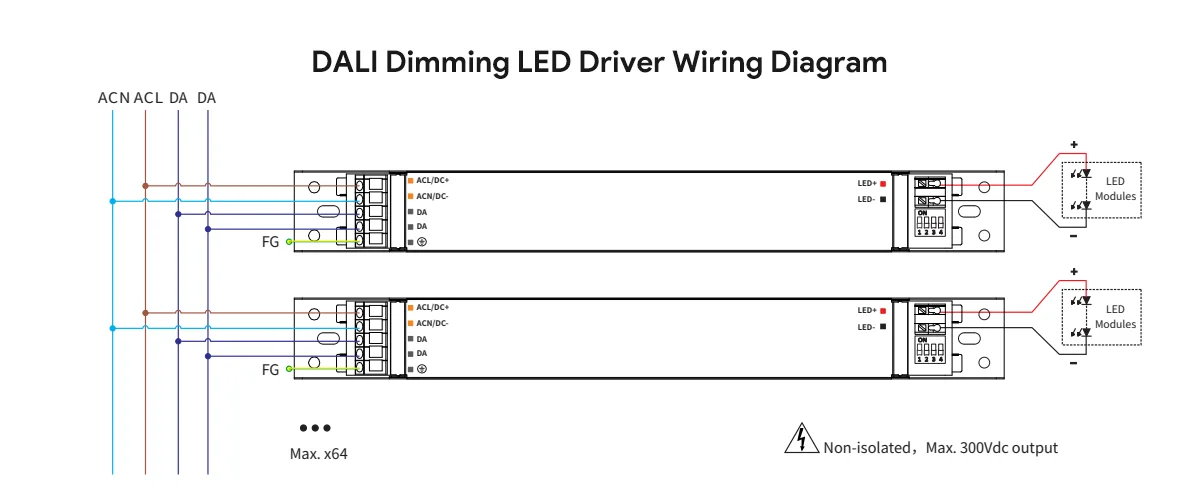
- 3-in-1 디밍: 3-in-1 디밍은 0-10V 디밍, PWM(펄스 폭 변조) 디밍, 저항(Rx) 디밍을 동시에 지원하는 LED 드라이버 기술을 의미하는 여러 디밍 기술을 결합한 통합 조명 제어 솔루션입니다.
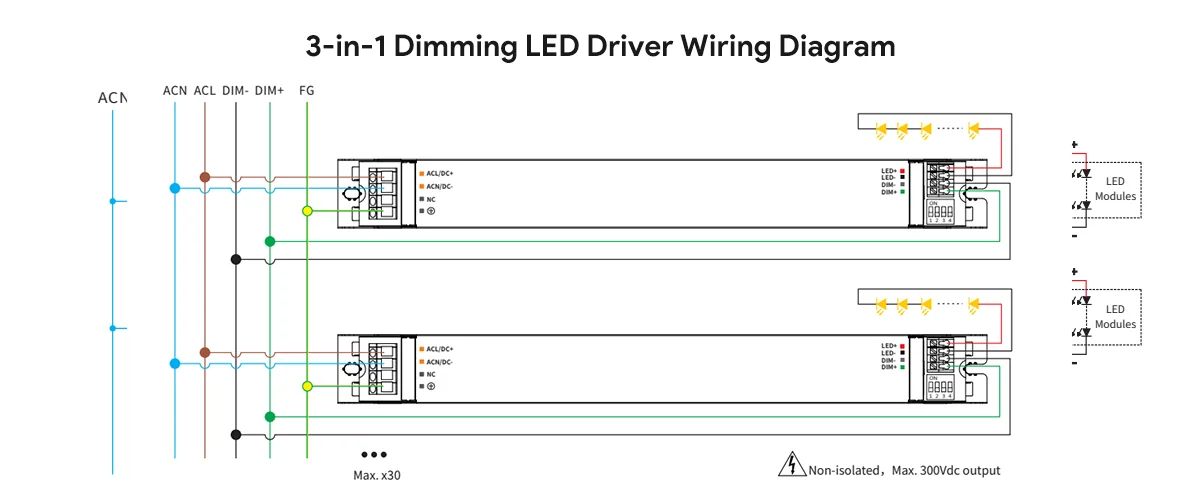
- a) 0-10V 디밍: 아날로그 디밍으로 분류되는 아날로그 전압 신호(0-10V DC)를 통해 드라이브 전류를 직접 제어합니다. 밝기 조정은 고주파 스위칭 없이 전압 변화에 의존합니다. 출력 전류는 0-10V DC 신호에 의해 제어되며, 0V에서 고정 장치를 끄고 10V에서 100% 밝기에 도달합니다.
- b) PWM 디밍: 플리커를 최소화하기 위해 1kHz 이상의 주파수를 지원해야 하는 고주파 스위칭을 통해 듀티 사이클을 조정합니다. PWM은 디지털 디밍 방식으로, 본질적으로 "ON"과 "OFF" 상태를 번갈아 제어합니다. 고정밀, 저비용 디밍이 필요한 시나리오에 적합합니다.
- c) 조절 저항(Rx) 디밍: 출력 전류를 조절하고 밝기를 제어하기 위해 전위차계를 통해 회로 저항을 변경합니다. 특성: 단순 회로이지만 저비용 솔루션에서 일반적으로 사용되는 낮은 정밀도.
- TRIAC 디밍: TRIAC 디밍은 트라이악(실리콘 제어 정류기)의 전도각을 조정하여 전류 크기를 제어하는 기술입니다. 핵심 원리는 AC 전력의 각 반파의 전도 시간(위상 각도)을 변경하여 출력 전압의 유효 값을 조정하여 부하 전력과 밝기를 조절하는 것을 포함합니다. 복잡한 배선 없이 간단한 설치가 필요한 시나리오에 적용됩니다.
4. 인증 및 안전

LED 드라이버의 인증 및 안전은 제품 규정 준수, 시장 접근 및 사용자 안전을 보장하는 데 매우 중요합니다. 주요 글로벌 시장은 EU, 독일의 TUV, 미국의 UL과 같은 고유한 안전 인증을 요구하는 국가에서 LED 운전자에 대한 필수 인증을 시행합니다.
현지 인증을 준수하는 운전자를 선택하면 안전과 법규 준수가 모두 보장됩니다. 이는 화물 구금, 벌금 또는 시장 금지와 같은 규제 위반 위험으로부터 제품을 보호합니다. 따라서 인증 심사 및 안전 설계 최적화는 조명 시스템의 전반적인 신뢰성을 크게 향상시킵니다.
5. 환경과 수명
LED 드라이버의 안정성과 수명은 작동 환경에 직접적인 영향을 미치므로 LED 시스템의 전반적인 신뢰성을 결정하는 데 중요한 요소가 됩니다. 고온, 습기 또는 먼지가 많은 환경에서 내부 드라이버 구성 요소는 전해 커패시터의 전해질 건조 또는 금속 부품의 산화와 같은 노화를 가속화하여 효율성 손실 또는 고장을 초래합니다.
장기간의 고온에 노출되면 LED 드라이버의 수명이 이론적으로 50,000시간에서 10,000시간 미만으로 줄어들 수 있습니다. 또한 계통 전압 변동과 잦은 스위칭 작업으로 인해 운전자에게 영향을 주어 수명을 더욱 단축시킬 수 있습니다.
따라서 적절한 설치 환경(예: 통풍이 잘되고 습기, 방진)을 선택하고 고품질 LED 드라이버를 사용하면 시스템 수명을 크게 연장하고 유지 관리 비용을 줄일 수 있습니다. 운전 조건을 최적화하면 운전자 성능이 향상될 뿐만 아니라 LED 장비의 장기간 안정적인 작동이 보장되어 경제적 이점을 극대화할 수 있습니다.
드라이버로 몇 개의 선형 LED 모듈을 실행할 수 있습니까?
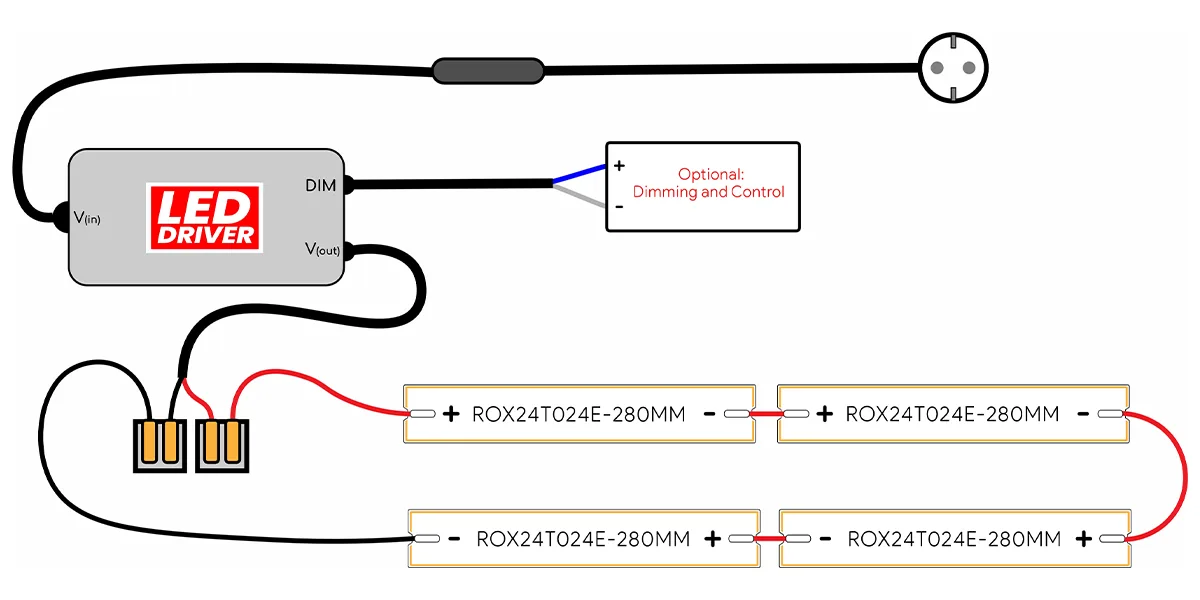
대부분의 전문 조명 시스템에서 선형 LED 모듈은 정전류 기술을 사용하여 구동됩니다. 이 설계는 각 모듈에 일관된 전류 흐름을 보장하여 균일한 밝기, 안정적인 색온도 및 연장된 수명을 제공합니다.
그렇다면 단일 정전류 드라이버는 몇 개의 선형 모듈을 전력으로 사용할 수 있습니까? 이것은 모듈의 작동 전압과 드라이버의 출력 전압 범위에 따라 다릅니다.
1. 운전자의 기본 매개변수 식별
정전류 드라이버에 대한 두 가지 중요한 사양은 다음과 같습니다.
- 출력 전류(mA): 예를 들어, 각 모듈이 전달할 전류를 나타내는 350mA, 500mA, 700mA, 1050mA.
- 출력 전압 범위(V): 직렬 연결 모듈의 최대 총 전압을 결정하는 DC25–54V, DC176–280V.
LED 선형 모듈은 정전류 시스템 내에서 직렬로 연결되어야 하며, 여기서 총 전압은 각 모듈의 전압의 합과 같습니다. 따라서, 드라이버의 출력 전압 범위는 직렬로 연결할 수 있는 최대 모듈 수를 직접 결정합니다.
2. 시리즈 모듈의 수 계산
가장 일반적인 350mA 정전류 드라이버(40–120V 출력)를 예로 사용합니다.
단일 모듈(560mm)의 순방향 전압(VF)이 44V인 경우 약 2.7개의 모듈을 직렬로 연결할 수 있습니다. 120V ÷ 44V ≈ 2.7 모듈. 실제로 10% 안전 마진이 권장되므로 2개의 모듈을 최적의 구성으로 만듭니다.
시스템은 전체 모듈 전압이 드라이버의 출력 범위 내에 있는 한 안정적으로 작동합니다. 전압이 최소 시동 전압(예: 36V)보다 낮으면 드라이버가 활성화되지 않습니다. 상한선(예: 120V 이상)을 초과하면 운전자는 과부하 보호를 유발하거나 깜박임이 나타납니다.
3. 효율성 및 열 설계 고려 사항
LED 드라이버는 전체 전압 범위에서 효율적으로 작동하지 않습니다. 일반적으로 드라이버의 정격 출력에서 70%-90% 내에서 총 모듈 전압을 유지하는 것이 좋습니다.
예를 들어, DC40–120V 드라이버는 약 44–110V 내에서 최적으로 작동합니다.이 범위에서 드라이버는 피크 효율을 달성하고 열을 줄이고 모듈 수명을 연장합니다.
또한 단일 고정 장치 내에서 여러 모듈 그룹을 직렬로 연결하는 경우 다중 드라이버 세그먼트 전원 공급 장치 설계를 권장합니다. 이를 통해 모든 모듈에서 일관된 밝기를 보장하고 유지 관리가 간소화되며 전력 균형을 쉽게 조정할 수 있습니다.
4. 프로젝트 시나리오에 따른 구성 최적화
프로젝트 설계 단계에서 다음 지침을 고려하십시오.
- 저전력 모듈(<10W): 4~6 시리즈 연결에 적합하며 200mA 또는 275mA 드라이버만 필요합니다.
- 중전압 모듈(10–15W): 350mA 또는 500mA 드라이버가 있는 권장 2–3 시리즈 연결이 더 큰 안정성을 제공합니다.
- 고전력 모듈 또는 COB 모듈: 일반적으로 1~2개의 직렬로 연결되어 고전압 출력 기능이 있는 드라이버를 선택합니다.
순방향 전압(VF)은 브랜드와 LED 패키지에 따라 약간 다릅니다. 따라서 항상 모듈의 데이터시트를 선택하기 전에 참조하고 운전자의 출력 범위와 정확하게 일치시키십시오.
드라이버가 전원을 공급할 수 있는 LED 선형 모듈의 수 결정:
- 정전류 드라이브에서 직렬로 연결된 모듈의 전압 스태킹 패턴;
- 운전자의 전압 범위 및 안전 마진;
- 전체 시스템의 효율성과 열 균형.
이 세 가지 점을 이해하면 최적의 드라이버-모듈 조합을 빠르게 식별할 수 있습니다.
SignLiteD에서는 고객이 제공한 드라이버 전류 매개변수, 모듈 전원 요구 사항 및 고정 장치 치수를 기반으로 맞춤형 정전류 모듈 솔루션을 제공합니다. 이를 통해 모든 선형 조명 시스템이 최적의 전기 조건에서 작동하도록 합니다.
피해야 할 일반적인 실수
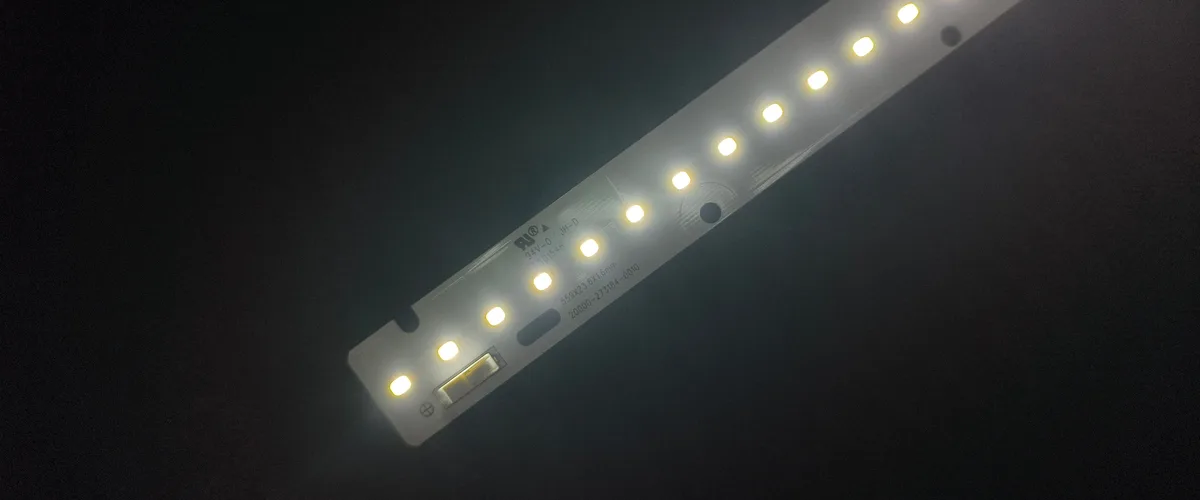
선형 LED 모듈이 있는 LED 드라이버를 사용할 때는 전기적 호환성, 장착 방법, 방열 및 신호 제어에 특별한 주의를 기울여야 시스템 작동이 안정적입니다.
전압 및 전류
드라이버의 출력 전류는 선형 모듈의 작동 전류와 일치해야 합니다. 과부하 및 과열을 방지하기 위해 ≥ 모듈의 총 전류 (예 : 500mA 모듈은 500mA 이상의 드라이버가 필요함) ≥이어야 합니다. 모듈의 최대 전류 정격을 초과하면 LED 칩이 소손될 위험이 있습니다.
선형 모듈은 일반적으로 저전압 설계(DC 20V/48V)를 특징으로 합니다. LED 모듈의 작동 전압이 전원 공급 장치의 출력 범위 내에 있는지 확인하십시오. 전원 공급 장치의 출력 전압이 모듈의 전압보다 낮으면 LED의 순방향 전압(VF)이 떨어지고 깜박임이 발생할 수 있습니다.
정전류/정전압 선택
대부분의 선형 모듈은 정전류 드라이브(100-400mA)를 사용하는 반면 일부는 정전압 드라이브(DC12V/24V/48V)를 필요로 합니다. 실제 조건에 따라 선택합니다. 정전압과 정전류를 혼합하면 불균일한 밝기나 손상을 일으킬 수 있습니다.
설치 및 배선
입력 및 출력 와이어를 올바르게 연결하고 역극성으로 인해 운전자가 손상될 위험이 있습니다. 직렬 또는 병렬 설치는 잘못된 연결로 인한 비조명 또는 모듈 손상을 방지하기 위해 전문적인 설치가 필요합니다.
방열 설계
선형 모듈은 알루미늄 기판이나 방열판에 장착해야 하며, 전체 전력 작동이 장기간 작동하지 않도록 빛이 붕괴되는 것을 방지합니다. 실외 또는 습기가 있는 환경의 경우 IP65 이상의 보호 등급을 가진 모듈 및 드라이버를 선택합니다. 드라이버 하우징은 녹슬지 않아야 합니다(예: 알루미늄 합금).
디밍 호환성
드라이버가 호환되지 않는 조광기로 인한 깜박임이 발생하지 않도록 PWM 디밍 프로토콜(예: 0-10V, DALI)을 지원하도록 합니다.
이러한 조치를 효과적으로 구현하면 LED 선형 모듈과 드라이버 간의 호환성 문제를 효과적으로 방지하여 시스템 수명을 연장할 수 있습니다.
결론
위의 내용은 선형 모듈용 LED 드라이버를 선택할 때 우선 순위를 지정하는 몇 가지 핵심 요소를 설명합니다. 이 정보가 도움이 될 것이라고 믿습니다.
Signliteed는 혁신적인 조명 기술을 전문으로 하며 조명 부품의 글로벌 표준화를 주도합니다. 우리의 개발 LED 선형 모듈 높은 발광 효율, 오래 지속되는 내구성 및 유연한 설치를 특징으로 하는 Zhaga 표준을 준수하십시오. 현재 제품은 LED 선형 조명 및 LED 트라이프루프 라이트를 비롯한 다양한 응용 분야에 적합합니다.
